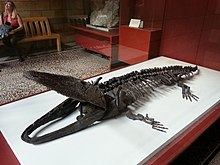This article needs additional citations for verification. (October 2022) |
| Paracyclotosaurus Temporal range: Middle Triassic
| |
|---|---|

| |
| Paracyclotosaurus davidi in the Natural History Museum of London | |
| Scientific classification | |
| Domain: | Eukaryota |
| Kingdom: | Animalia |
| Phylum: | Chordata |
| Order: | †Temnospondyli |
| Suborder: | †Stereospondyli |
| Clade: | †Capitosauria |
| Family: | †Mastodonsauridae |
| Genus: | †Paracyclotosaurus Watson, 1958 |
| Species | |
| |
Paracyclotosaurus (meaning "Near Wheeled Lizard") is an extinct genus of temnospondyl, which would have appeared similar to today's salamander – but much larger, measuring up to 2.45 m (8.0 ft) long and weighing between 159 and 365 kg (351 and 805 lb).[1] It lived in the Middle Triassic period, about 235 million years ago, and fossils have been found in Australia, India, and South Africa.
Although they could live on dry land, Paracyclotosaurus probably spent most of its time in water. They had flattened bodies and elongated heads, almost 60 centimetres (2 ft) long, that vaguely resembled those of modern crocodiles.[2]
- ^ Hart, L.J.; Campione, N.E.; McCurry, M.R. (2022). "On the estimation of body mass in temnospondyls: a case study using the large-bodied Eryops and Paracyclotosaurus". Palaeontology. 65 (6): e12629. doi:10.1111/pala.12629.
- ^ Palmer, D., ed. (1999). The Marshall Illustrated Encyclopedia of Dinosaurs and Prehistoric Animals. London: Marshall Editions. p. 53. ISBN 1-84028-152-9.